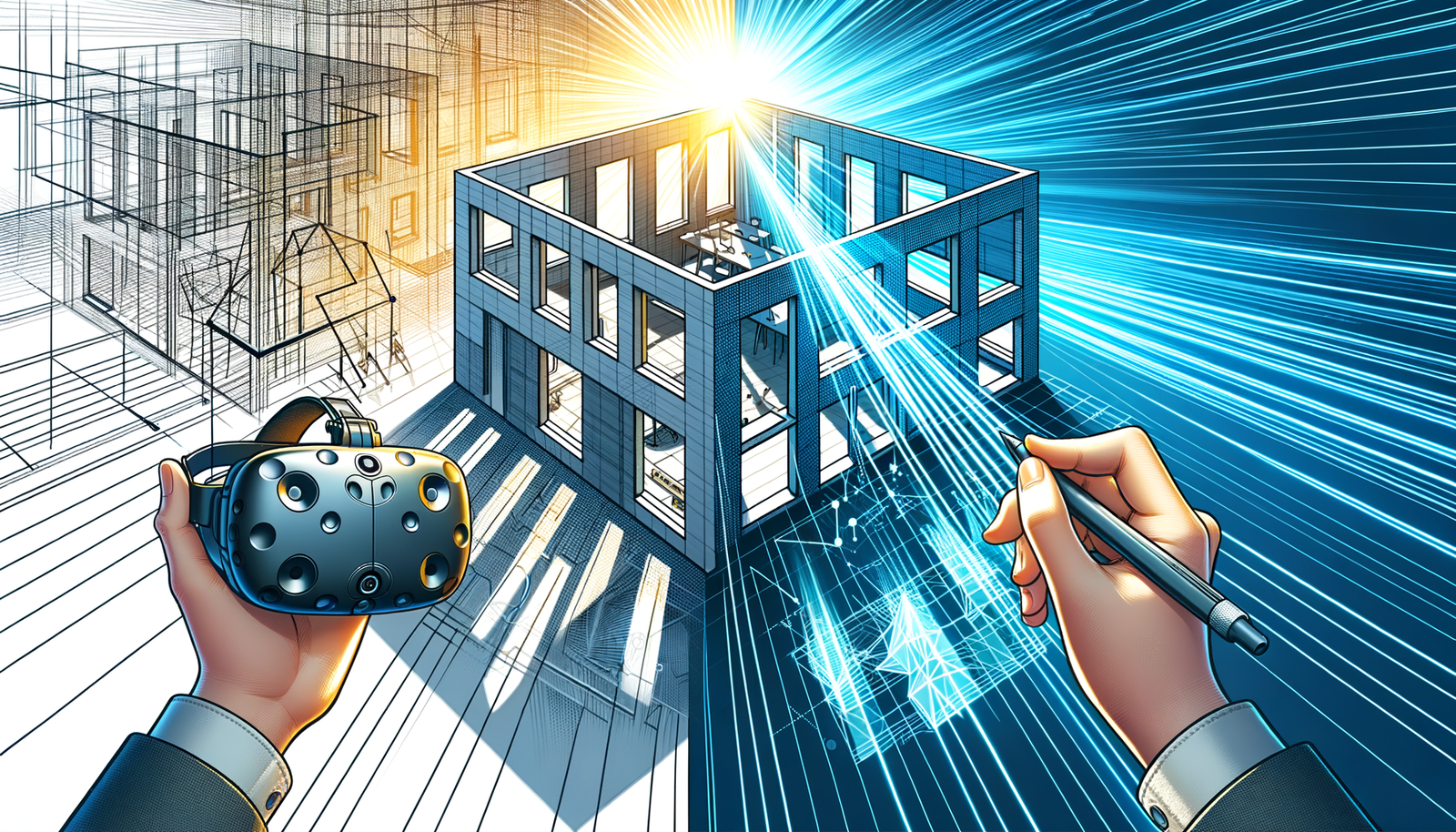Your Cart is Empty
Customer Testimonials
-
"Great customer service. The folks at Novedge were super helpful in navigating a somewhat complicated order including software upgrades and serial numbers in various stages of inactivity. They were friendly and helpful throughout the process.."
Ruben Ruckmark
"Quick & very helpful. We have been using Novedge for years and are very happy with their quick service when we need to make a purchase and excellent support resolving any issues."
Will Woodson
"Scott is the best. He reminds me about subscriptions dates, guides me in the correct direction for updates. He always responds promptly to me. He is literally the reason I continue to work with Novedge and will do so in the future."
Edward Mchugh
"Calvin Lok is “the man”. After my purchase of Sketchup 2021, he called me and provided step-by-step instructions to ease me through difficulties I was having with the setup of my new software."
Mike Borzage
Harnessing Advanced Lighting Simulation Tools in Modern Architectural Design
April 06, 2025 9 min read


In modern architectural design, lighting plays a pivotal role in shaping both the functionality and aesthetics of spaces. With the advent of advanced technology, lighting simulation tools have become essential assets for architects, enabling them to visualize and optimize lighting schemes with unprecedented precision.
Importance of Lighting in Architectural Design
Lighting is more than just a practical necessity; it is a fundamental component that profoundly influences the character and usability of architectural spaces. The strategic use of lighting can dramatically enhance the aesthetics and functionality of spaces, highlighting architectural features, creating depth, and setting the desired ambience. By manipulating light and shadow, architects can guide the visual experience, drawing attention to focal points and creating a sense of harmony within the environment.
Moreover, lighting has a significant impact on the mood, productivity, and well-being of occupants. Properly designed lighting schemes can evoke specific emotional responses, promote comfort, and improve overall satisfaction within a space. For instance, ample natural light is known to boost morale and productivity in work environments, while warm, subdued lighting can create a relaxing atmosphere in residential settings. Understanding the psychological effects of lighting allows architects to design spaces that not only meet functional requirements but also contribute to the health and happiness of those who use them.
In addition, lighting plays a crucial role in safety and accessibility. Adequate illumination ensures that spaces are navigable and secure, reducing the risk of accidents and enhancing the overall user experience. By prioritizing lighting in the design process, architects can create environments that are both beautiful and highly functional, meeting the diverse needs of occupants.
Evolution of Lighting Simulation Tools
Over the years, lighting simulation tools have undergone a remarkable transformation. Initially, architects relied on basic 2D representations and manual calculations to predict lighting outcomes, which often resulted in approximations rather than precise visualizations. With technological advancements, these tools have evolved into sophisticated 3D simulations that offer a more accurate and immersive understanding of how light interacts within a space.
The integration of physics-based rendering techniques has been a game-changer in lighting simulation. These techniques allow for the realistic portrayal of light behavior, including reflections, refractions, and dispersion. By simulating the physical properties of light and materials, architects can anticipate how natural and artificial lighting will affect their designs under various conditions. This level of detail was previously unattainable and has significantly improved the accuracy of lighting predictions.
Furthermore, the evolution of lighting simulation tools has been marked by increased accessibility and user-friendliness. Advancements in computational power and software design have made these tools more intuitive, allowing architects with varying levels of technical expertise to leverage their capabilities effectively. This democratization of technology has led to widespread adoption in the industry, enhancing the overall quality of architectural lighting design.
Current Trends and Technological Advancements
The field of lighting simulation is continuously advancing, with several trends shaping its future. One significant development is the adoption of real-time rendering engines. These engines enable architects to receive instant feedback on lighting changes, greatly accelerating the design process. Real-time simulations allow for dynamic interactions with the model, making it possible to assess lighting effects immediately after modifications are made.
Another trend is the utilization of artificial intelligence (AI) for predictive lighting models. AI algorithms can analyze vast amounts of data to predict optimal lighting configurations based on user preferences, environmental conditions, and energy efficiency goals. By incorporating AI, lighting simulation tools can offer automated suggestions and optimizations, streamlining the design process and helping architects achieve better outcomes.
Increased interoperability with other design software, such as Building Information Modeling (BIM) and Computer-Aided Design (CAD) platforms, is also a notable advancement. This interoperability allows for seamless data exchange and integration, fostering a more cohesive and efficient design workflow. Architects can now incorporate detailed lighting simulations into their broader design processes without the need to switch between disparate tools, enhancing collaboration and reducing the potential for errors.
Real-Time Rendering and Interactive Simulations
Real-time rendering and interactive simulations have revolutionized the way architects approach lighting design. By providing instant feedback on lighting changes, these tools allow designers to experiment with different lighting scenarios quickly and efficiently. Architects can adjust light sources, alter material properties, and modify environmental conditions to observe the immediate effects on the overall design.
Interactive simulations enable architects to conduct virtual walkthroughs of their designs, assessing how lighting impacts the space from various perspectives. This immersive experience is invaluable for identifying potential issues and making informed decisions. It also facilitates better communication with clients and stakeholders, who can experience the design in a more tangible way.
Moreover, real-time rendering enhances the iterative nature of the design process. Architects can explore a multitude of options without the time constraints imposed by traditional rendering methods. This flexibility leads to more innovative and refined lighting solutions, ultimately resulting in higher-quality architectural designs.
Integration with Building Information Modeling (BIM) and CAD Platforms
The integration of lighting simulation tools with BIM and CAD platforms has significantly improved the efficiency and accuracy of architectural design workflows. By enabling seamless data exchange, architects can ensure that their lighting designs are fully coordinated with other aspects of the project, such as structural elements, mechanical systems, and spatial layouts.
This integration fosters enhanced collaboration among architects, engineers, and designers. With all team members working within a unified platform, it becomes easier to identify and resolve conflicts, share updates, and maintain consistency across the project's development. The result is a more cohesive design process that minimizes errors and reduces the need for costly revisions.
Furthermore, BIM integration allows for better lifecycle management of buildings. Lighting simulations can be linked to building performance analyses, informing maintenance strategies and future renovations. This holistic approach ensures that lighting design contributes positively to the building's long-term functionality and sustainability.
Support for Diverse Lighting Types and Environmental Conditions
Advanced lighting simulation tools offer comprehensive support for a wide range of lighting types and environmental conditions. Architects can simulate natural light, artificial lighting, and mixed lighting scenarios to understand how different sources interact within a space. This capability is crucial for designing environments that are both visually appealing and functionally appropriate.
Simulation tools can model different times of day and seasonal variations, providing insights into how sunlight will affect a space throughout the year. This is particularly important for projects aiming to maximize natural light for energy efficiency or aesthetic purposes. By accounting for variables such as solar position, weather patterns, and geographical location, architects can optimize window placements, shading devices, and material selections to achieve the desired lighting outcomes.
Additionally, these tools can simulate various artificial lighting technologies, including LEDs, fluorescents, and halogens, each with unique characteristics. Architects can evaluate the impact of different fixtures, luminaire distributions, and color temperatures on the overall design. This level of detail ensures that the final lighting scheme aligns with the project's functional requirements and aesthetic vision.
Accurate Material and Texture Representation
One of the key features of modern lighting simulation tools is the realistic depiction of how materials interact with light. Accurate material and texture representation are essential for understanding the visual dynamics of a space. By simulating properties such as reflectivity, translucency, and absorption, architects can predict how surfaces will appear under various lighting conditions.
This enhanced visualization allows for more informed material selections. Architects can assess how different finishes, colors, and textures will impact the ambience and functionality of a space. For example, glossy surfaces may contribute to unwanted glare, while matt finishes might absorb too much light, leading to darker environments. By analyzing these factors during the design phase, architects can make adjustments to achieve the optimal balance.
Furthermore, accurate material representation supports better coordination with other design elements. Lighting simulations that consider material properties contribute to more cohesive and harmonious designs, as the interplay between light and materials is integral to the overall aesthetic. This attention to detail elevates the quality of architectural projects and enhances the experience for occupants.
AI-Driven Predictive Lighting Models
The incorporation of artificial intelligence in lighting simulation tools has opened new possibilities for optimizing lighting designs. AI-driven predictive lighting models utilize machine learning algorithms to analyze data from previous projects, environmental conditions, and user preferences. These models can generate optimized lighting solutions that balance aesthetic appeal, functionality, and energy efficiency.
One of the significant benefits of AI integration is the ability to automate adjustments based on environmental data. For instance, the system can suggest modifications to the lighting design in response to changes in natural light availability or occupancy patterns. This dynamic approach ensures that the lighting remains effective and efficient under varying conditions.
AI-driven models also contribute to the optimization of lighting for energy efficiency. By analyzing factors such as energy consumption, lumen output, and maintenance costs, AI can recommend configurations that minimize energy use without compromising on quality. This aligns with the growing emphasis on sustainability in architecture, helping designers meet regulatory standards and achieve certifications for green building practices.
Enhancing Design Accuracy and Decision-Making
Advanced lighting simulation tools significantly enhance design accuracy, enabling architects to make more informed decisions throughout the design process. The ability to visualize precise lighting effects helps in identifying potential issues early, reducing the likelihood of costly changes during construction. By providing a realistic preview of the final outcome, architects can adjust their designs to better meet the project's goals and client expectations.
Furthermore, precise visualization leads to informed design choices regarding the selection of fixtures, materials, and spatial configurations. Architects can experiment with different options in a risk-free virtual environment, assessing the impact of each decision on the overall design. This iterative process facilitates the refinement of concepts, leading to more innovative and effective solutions.
Minimizing errors and misunderstandings in lighting plans is another critical benefit. Clear and accurate simulations help communicate the design intent to contractors, consultants, and clients, ensuring that everyone involved has a shared understanding of the project's lighting aspects. This clarity reduces the potential for misinterpretations and discrepancies during implementation.
Improving Energy Efficiency and Sustainability
Lighting simulation tools play a vital role in promoting energy efficiency and sustainability in architectural design. By optimizing the use of natural and artificial light, architects can significantly reduce a building's energy consumption. Simulations allow for the strategic placement of windows, skylights, and shading devices to maximize natural light while minimizing heat gain or loss.
Advanced tools also support the integration of energy-efficient lighting technologies, such as LED fixtures and smart lighting controls. By analyzing the energy performance of different systems, architects can select options that offer the best balance of efficiency and functionality. This contributes to lower operating costs and aligns with environmental sustainability goals.
Furthermore, lighting simulations support compliance with sustainable building certifications and standards, such as LEED or BREEAM. By providing detailed analyses of lighting performance, architects can demonstrate how their designs meet or exceed the criteria for energy efficiency and occupant comfort. This not only adds value to the project but also promotes environmental responsibility within the industry.
Streamlining Collaboration Among Design Teams
Effective collaboration is essential in the complex process of architectural design. Lighting simulation tools facilitate this by providing a unified platform for architects, engineers, and clients to review and refine lighting designs. Shared visualizations and simulations make it easier for all stakeholders to understand the design intent and provide valuable feedback.
Enhanced communication through visual tools reduces the potential for misunderstandings and ensures that everyone is aligned with the project's objectives. Team members can collaboratively explore different scenarios, address concerns, and make collective decisions based on accurate data. This collaborative approach accelerates the design process and leads to more cohesive and successful outcomes.
Additionally, the ability to share detailed simulations with clients enhances transparency and trust. Clients can visualize the lighting effects within their spaces before construction begins, allowing them to provide input and feel more connected to the project. This level of engagement often leads to higher satisfaction and fosters stronger relationships between architects and their clients.
Reducing Prototyping Costs and Time
The use of advanced lighting simulations considerably reduces the need for physical prototypes, resulting in significant cost and time savings. Virtual simulations provide a comprehensive understanding of how lighting will affect a space, eliminating the expenses associated with building and modifying physical models. Architects can iterate designs swiftly, making adjustments based on simulation feedback without incurring additional material costs.
This efficiency leads to faster iteration cycles and design modifications. By accelerating the design process, architects can meet tight project deadlines and respond quickly to client requests or regulatory changes. The ability to test and refine ideas in a virtual environment allows for more innovative solutions, as architects can explore a broader range of possibilities without the usual constraints.
Furthermore, reducing prototyping costs contributes to more sustainable practices by minimizing waste. By relying on digital models instead of physical prototypes, architects decrease the consumption of resources and the environmental impact associated with materials and transportation. This aligns with the industry's growing commitment to sustainability and responsible resource management.
In conclusion, advanced lighting simulation tools have become indispensable in modern architectural design. By offering precise visualizations, integrating with other design platforms, and incorporating AI technologies, they significantly enhance architects' ability to create spaces that are functional, aesthetically pleasing, and energy-efficient. The continued advancements in this field promise even greater innovations, with real-time rendering and AI integration paving the way for more intelligent and sustainable lighting solutions. As these technologies evolve, they will undoubtedly play a crucial role in shaping the future of architectural design, ensuring that lighting remains a central component in creating environments that enrich the lives of their occupants.
Also in Design News

Rhino 3D Tip: SaveSmall: Reduce .3dm File Size by Removing Cached Render Meshes
October 28, 2025 2 min read
Read More
ZBrush Tip: Project All Best Practices: Preserve Sculpt Detail, Polypaint, and Topology
October 28, 2025 2 min read
Read MoreSubscribe
Sign up to get the latest on sales, new releases and more …



